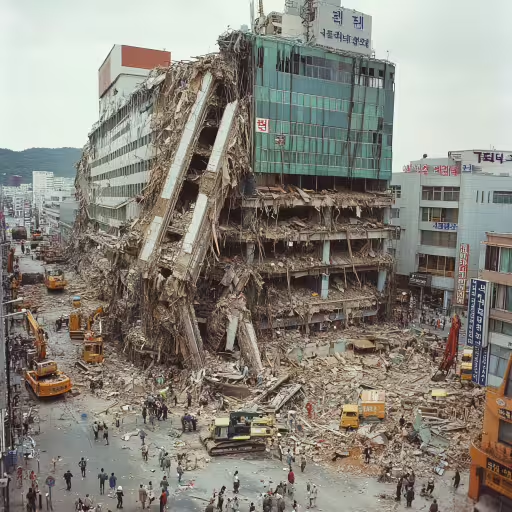Subtotal $0.00
The 1995 collapse of the Sampoong Department Store in Seoul, South Korea, remains one of the most catastrophic structural failures in modern history. The disaster claimed over 500 lives and left thousands injured, highlighting the critical importance of proper risk assessments and stringent regulatory compliance in construction. This case study serves as a stark reminder of the dangers of neglecting risk assessment and management in infrastructure development.
Understanding the Tragic Outcomes
The collapse of the five-story Sampoong Department Store was not an unforeseen accident but a failure of risk management at multiple levels. The building, which was initially designed as an office complex, underwent unauthorized modifications to become a department store. The additional floors and the use of substandard materials compromised the structural integrity of the building. The tragic outcomes included:
- Mass Casualties and Injuries: Over 500 people lost their lives, and thousands were injured, leaving a long-lasting impact on families and the community.
- Economic and Legal Consequences: The disaster led to lawsuits, fines, and legal actions against those responsible, demonstrating the importance of accountability in construction and engineering.
- Loss of Public Trust: The event shook public confidence in construction standards and regulatory enforcement, prompting calls for stringent reforms.
Root Causes of the Collapse
An effective risk assessment module could have identified the structural vulnerabilities that led to the disaster. However, the failure to implement such measures resulted in:
- Illegal Structural Modifications: The addition of extra floors and unauthorized changes increased the building’s weight beyond its designed capacity.
- Use of Inferior Materials: Contractors opted for substandard materials to cut costs, significantly weakening the building’s load-bearing capacity.
- Poor Construction Practices: Construction shortcuts, lack of adherence to building codes, and disregard for engineering safety measures contributed to the disaster.
- Lack of Oversight and Regulation: Insufficient monitoring by regulatory authorities allowed these violations to go unchecked, demonstrating the need for a robust risk management solution in construction projects.
Lessons in Risk Management and Compliance
The Sampoong Department Store collapse serves as a powerful case study in risk assessment and management. Several key lessons emerge from this disaster:
- The Need for Comprehensive Risk Assessments
Proper risk assessments should be conducted at every stage of construction, from design to execution. This includes evaluating:
- Structural stability
- Load capacity calculations
- Compliance with safety regulations
- Material quality and durability
- Enforcing Strict Building Codes
Regulatory bodies must impose and enforce stringent building codes to prevent unauthorized modifications and the use of substandard materials. Governments should implement technology-driven risk management software to monitor construction projects in real time.
- Regular Safety Audits and Inspections
Buildings, particularly commercial structures, should undergo periodic inspections to assess their structural integrity. Regular safety audits help identify potential risks before they escalate into catastrophic failures.
- Holding Professionals Accountable
Contractors, engineers, and developers must adhere to ethical standards and professional responsibilities. Severe penalties should be imposed on those who compromise safety for financial gains.
Strengthening Industry Standards to Prevent Future Disasters
To ensure structural safety and prevent tragedies like the Sampoong Department Store collapse, the construction industry must adopt the following measures:
- Enhanced Oversight and Compliance
- Government agencies must implement advanced risk management solution that facilitate real-time tracking of construction projects.
- Developers should integrate a risk assessment module into project planning to evaluate potential threats and implement corrective actions.
- Advanced Training and Certification
- Engineers, architects, and construction workers must undergo specialized training in safety protocols, compliance, and ethical responsibilities.
- Training programs should incorporate modern risk management software to equip professionals with the tools necessary for comprehensive risk mitigation.
- Proactive Safety Audits
- Mandating regular safety audits for commercial buildings will help in identifying and addressing structural vulnerabilities before they pose a risk to occupants.
- Risk assessment and management practices should be standardized to ensure uniform safety measures across all construction projects.
Conclusion: The Role of Modern Risk Management Solutions
The Sampoong Department Store collapse underscores the importance of proactive risk management in construction and infrastructure projects. Today, businesses and regulatory bodies have access to cutting-edge risk management software that can predict and mitigate risks before they lead to disasters.
For organizations looking to enhance safety standards, integrating a risk assessment module into their compliance strategies is essential. These solutions help businesses identify vulnerabilities, conduct real-time monitoring, and ensure regulatory compliance, ultimately safeguarding lives and assets.
Investing in robust risk management solutions is not just a regulatory necessity but a moral obligation to prevent tragedies like the Sampoong Department Store collapse. By embracing technology-driven risk assessments and rigorous safety protocols, we can build a safer, more resilient future for all.
For more information on how our solutions can help your organization stay ahead, contact us today at +353 21 4536034 or email info@ehasoft.com. Visit our website www.ehasoft.com to learn more.







Comments are closed